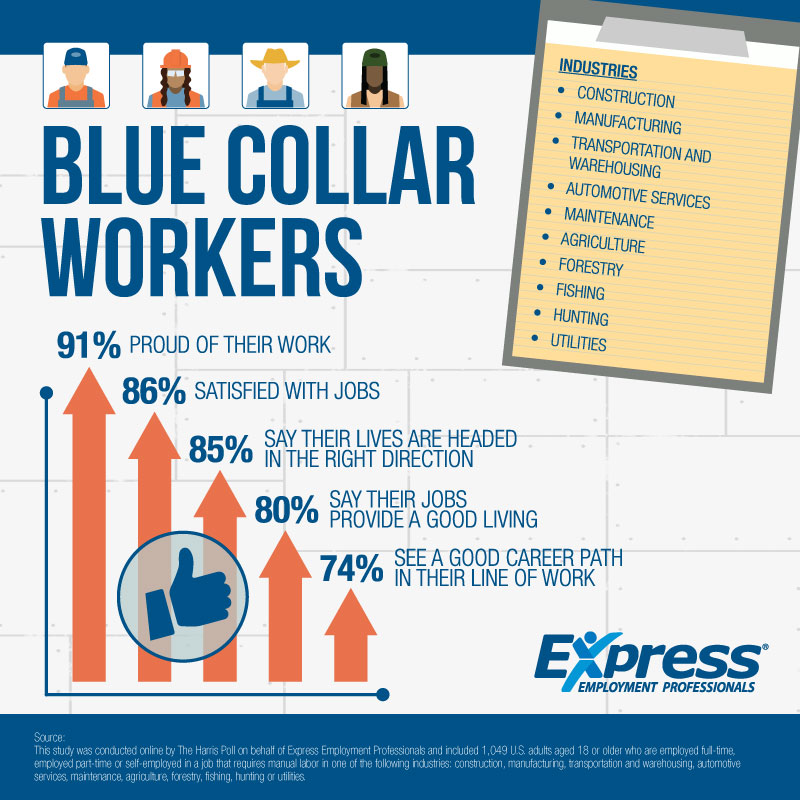By: Staff – expresspros.com – August 29, 2018
America’s blue collar workers may be one of the most optimistic groups in the country today. According to a new study conducted by The Harris Poll and commissioned by Express Employment Professionals, 85 percent of America’s blue collar workers see their lives heading “in the right direction.”
Sixty-nine (69) percent also say their local communities are heading in the right direction, and 51 percent say the same about the country as whole. That is 12 percentage points higher than among all Americans who say the country is heading in the right direction (39 percent), according to the July edition of the Harvard-Harris Poll polling average. [i]
The national survey of 1,049 blue collar workers was conducted online by The Harris Poll between July 9 and 23, 2018, on behalf of Express and offers a detailed, in-depth look at the background and attitudes of those working in blue collar professions.
“There’s been a great deal of chatter about the future and frustrations of America’s blue collar workers,” said Express CEO Bill Stoller. “Our survey reveals that blue collar workers are upbeat, optimistic and proud of the work they do. While the news is often full of stories about economic anxieties, this survey shows workers who are exceptionally optimistic. While they certainly express concerns, it’s clear that the vast majority feel like things will work out for themselves and their families.”
Who are America’s blue collar workers?
The survey included workers who are employed full-time, part-time or self-employed in a job that requires manual labor in one of the following industries: construction, manufacturing, transportation and warehousing, automotive services, maintenance, agriculture, forestry, fishing, hunting or utilities.
40-hour work weeks, hourly pay, indoors and outdoors
On average, U.S. blue collar workers have been working for a total of 22 years and in their current jobs for approximately 10 years.
On average, blue collar workers in the U.S. work about 41 hours per week.
- 8 percent work less than 30 hours per week
- 13 percent work 30 to 39 hours per week
- 60 percent work 40 to 49 hours per week
- 19 percent work more than 50 hours per week
The majority (80 percent) report that they are paid hourly, while 15 percent characterize their pay as salaried, and 5 percent are not sure. Forty-two (42) percent say they work mostly indoors, 23 percent say they work mostly outdoors, 30 percent say their time is split between the two locations, and 5 percent say they work inside a vehicle.
Labor unions: fans but not members
The majority are supportive of labor unions but are not members themselves. Seventy-three (73) percent somewhat or strongly agree that “unions help the working man and woman,” but only 13 percent are members of a labor union.
Low trust in elected officials
Only 30 percent of U.S. blue collar workers say they trust elected government officials and about half of blue collar workers (51 percent) believe that the federal government is pro-business (men more so than women, 58 percent vs. 32 percent). Blue collar workers are slightly more likely to identify with the Democratic party, 35 percent vs. 31 percent for Republicans. By a small margin, they think Republicans do a better job of helping blue collar Americans than Democrats, 39 percent vs. 36 percent. Nearly one in four (24 percent) believe neither party does a better job helping blue collar Americans.
Split between skilled trade and general labor
Roughly half of blue collar workers (49 percent) identify their work as a skilled trade, while another 44 percent would describe their work as general labor. Nearly 1 in 5 blue collar workers (18 percent) say using technology is a significant part of their job.
Blue collar workers say they are “better off,” but are less certain about the country’s direction.
Blue collar workers are satisfied with-and proud of-their jobs.
About the Survey
…
To read more about these headings, click read more.
Source: America’s blue collar workers may be one of the most optimistic groups in the country today.
 Listen Online
Listen Online Watch Online
Watch Online Find a Station in Your Area
Find a Station in Your Area







 Listen Now
Listen Now Watch Online
Watch Online
